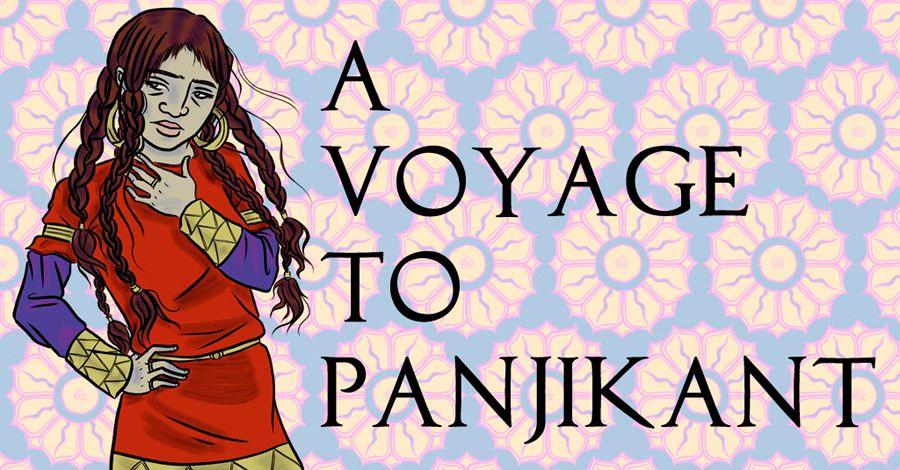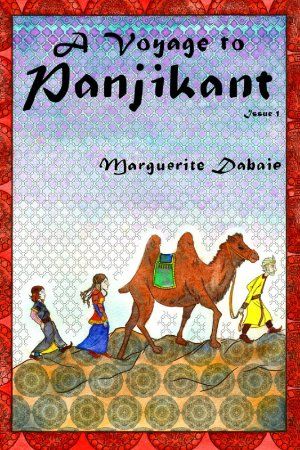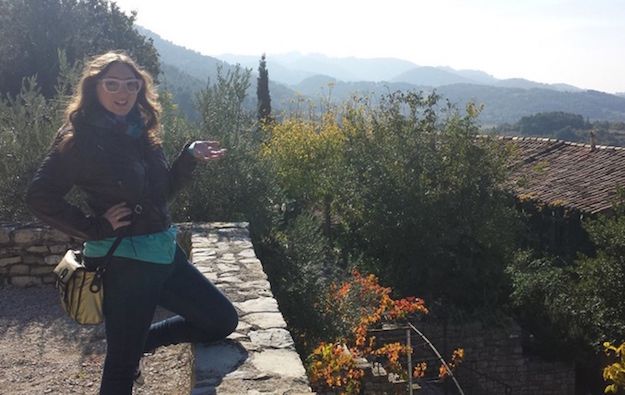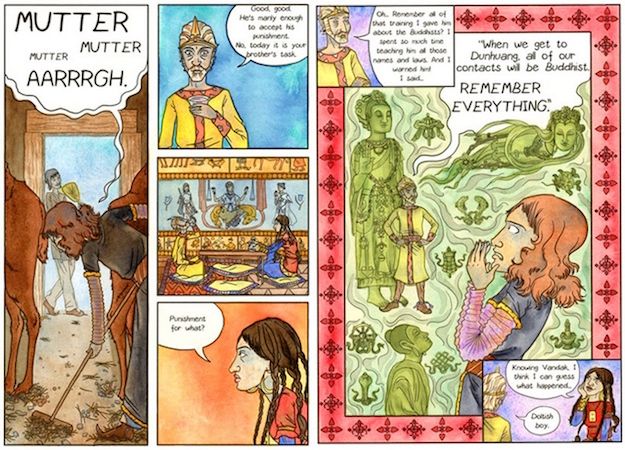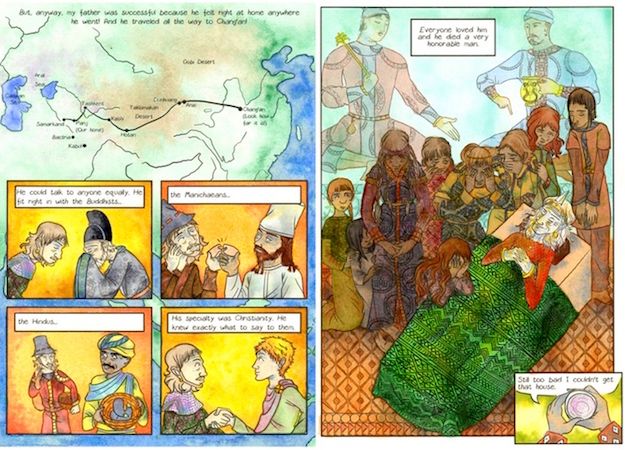Marguerite Dabaie's A Voyage to Panjikant is a fascinating look at a long-lost culture.
It's set in the 7th century, along the Silk Road of Central Asia, a major highway for traders and therefore a place where many cultures met and mingled. Dabaie chose the Sogdians, who were sort of the middlemen of all this, as the culture in which to set her story.
The Sogdians were real, but their culture is long gone, so she had to do extensive research — and use a bit of imagination — to reconstruct their lives. Her Kickstarter campaign has already reached its goal, but she has some exclusives and stretch goals for backers.
We spoke with Dabaie briefly about A Voyage to Panjikant and crowdfunding.
ROBOT 6: Your story is set in the Silk Road. What part of the world is this today, and how was it different then from the way it is now?
Marguerite Dabaie: The story takes place in what was the Kingdom of Sogdiana, now roughly modern-day Tajikistan and Uzbekistan. The biggest difference is that the population in the 7th century was primarily Zoroastrian, one of the oldest religions still in practice today. The Islamic Conquests were beginning but didn’t actually reach Sogdiana until the 8th century — Sogdians then converted on a large scale in order to avoid paying steep taxes (really, a very Sogdian thing to do).
Do you have a personal connection with this subject matter?
Yes and no. I’m not directly connected to any of the regions that I write about in this comic — however, if I was going to create a historical comic, it felt important to me to write about something outside of what’s more commonly known in Western history. I went in hardly knowing anything about who the Sogdians were and I wanted this to be a learning experience for both myself and readers.
I also wanted this to be an opportunity to talk about certain themes in a historical light. My previous comic, The Hookah Girl, was an autobio about myself and my Palestinian family. I think the subject was too loaded for people (and publishers) to largely accept, regardless of what themes I brought up; history is a great way to soften the blow.
What inspired the story, and which came first — characters, setting or plot?
I knew I wanted to write a story in the past that mirrored both modern-day social accomplishments and mores, though at first I wasn’t entirely sure what form that would take. I thought maybe medieval Europe would do well (and that’s a time period I’m really knowledgeable of), but the idea didn’t really sit well and, frankly, drawing a whole book’s worth of medieval Europe just didn’t seem fun enough for me.
The Silk Road started looking like a better option because there’s so much material to work with (so many types of people and religions), was arguably the most important invention for over 1,000 years because of all the exchange of ideas it allowed, and (here’s a biggie) I really, really love the arts of East Asia/Central Asia/the Middle East at this time.
Once I really started researching Sogdian and Chinese contemporary society, everything clicked into place.
How did you research it?
For any books I've needed (usually very academic texts), WorldCat has been a great resource. I’m lucky that I live in NYC, and most of the books are in one library or another around here — WorldCat pinpoints which libraries have which books.
There are a good number of articles and heavily academic magazines that can be found online. JSTOR helps with this. Through the magic of the Internet, I’ve also befriended quite a number of people who are into this stuff as much as I am so we swap articles/PDFs/leads if one of us finds a new resource. That helps a lot.
How much do we know about this time period, in terms of the social mores and the role of women? Are you concerned about overlaying a modern sensibility onto historical characters?
Here’s the rub: There’s a limited amount of material on the Sogdians in English. There isn’t as much material on them as, say, Tang Dynasty China, who are just more popular, period. Because of this, I’ve had to take some liberties with historical accuracy. I don’t know what Sogdians ate exactly, because I haven’t been able to find a source that actually discusses that, though I know a lot about what the Chinese ate at the time because it’s been well documented. So I need to instead look at what modern-day Tajiks and Uzbeks eat and extrapolate that information.
That said, we do have evidence that the Sogdians were comparatively less restrictive regarding the roles of women in society. We’re super lucky that a huge cache of Sogdian letters and legal documents were found at Mt. Mugh that help give insight on contemporary views of gender and race. In the pile, for example, was a marriage contract that stated that if the husband didn’t treat the wife respectfully, she had the right to leave, take back her property, and remarry. (They did practice polygamy, which adds an extra facet that really interests me — but the contract suggests that they strived for more harmonious arrangements.) During this same time period, China had much more restrictive laws regarding marriage and made it nearly impossible for women to leave abusive marriages.
There’s also evidence that the Sogdians were relatively accepting of other races and cultures — which makes sense, considering that they were dead center of the Silk Road, where all these people would travel, and they were known as traveling merchants themselves who would often make sojourns to other regions. They still had their social problems … and they were big problems. I address these in the book.
When I first started writing the script, I was worried at first about overlaying a modern sensibility, but I realized that in order to make the story resonate with us, I would need to, at least a little. This is probably most obviously evident in how the characters speak, because if I really wanted to be realistic the translation from Sogdian to English would sound a lot more archaic; instead, I went for more casual language without slang. The story is primarily fiction with all of the historical elements as a backdrop — I want the history to be an intrinsic part of the story but I don’t want it to get in the way of the storytelling. It’s a very fine line.
Did you weave any actual historical events or people into the story?
The Islamic Conquests are talked about a bit in the story, as they’re starting to build momentum at this time (Sasanian Persia is overtaken by the conquests, specifically). It’s spoken of in a “I heard this rumor” sort of way. While I deliberately timed the story so that the Islamic Conquests would not be a major event in the side of Asia I'm dealing with, I wanted them to be evoked to bring in the element of change.
Why did Kickstarter make sense for A Voyage to Panjikant?
I pitched the comic to many publishers and agents — many of whom said they enjoyed the concept and story, but were not interested in further representation.
I was reluctant to Kickstart the book at first, but I had gotten advice that Kickstarter is a great way to get the project under as many noses as possible, and I have to say that it has been great for that. This is my first ever Kickstarter and I really only wanted to do this for a book that I know needs to be out there. I’m incredibly thrilled that the passion I have for this book is coming through enough that people are backing it.
How will you distribute the book? Will it only go to Kickstarter backers or will you be looking for a wider audience?
I plan on distributing the book outside of Kickstarter. All of the backer’s rewards, however, except for A Crash Course on the Sogdians, are especially made for the campaign and won’t be redistributed elsewhere.
For the campaign, the Crash Course book will be reprinted professionally — if anyone knows my first iteration of the book, I printed it from my home printer, so this will be a big improvement!

